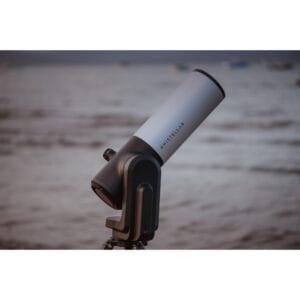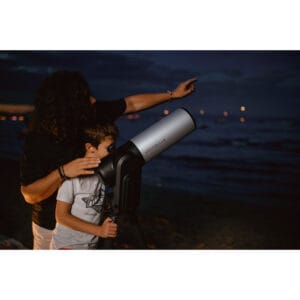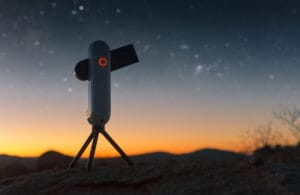Telescopes open a window to the universe — but when you’re just starting out, that window can sometimes be surprisingly cloudy. Why can’t you see anything? Which Telescope is Right for You? And what about light years and the boundaries of the observable universe?
In this blog, we answer the most frequently asked questions from our thousands of customers, so you can confidently dive into exploring the galaxy.
Why Can’t I See Anything through My Telescope?
A frustrating experience, but fortunately usually easy to fix. Here are the most common causes:
- Lack of focus: Always start with a bright object like the moon. Slowly turn the focus knob until the image is sharp.
- Wrong eyepiece: Use a low-power eyepiece (like 25mm) to find objects more easily.
- Moving celestial bodies: The Earth rotates — meaning objects slowly disappear from view. Align your telescope properly and track the object.
- Light pollution: City lights can severely limit your visibility. If possible, go to a dark location outside the city.
Can You See Jupiter During the Day?
Yes, you can — though it’s not easy. With a good telescope and experience, you can locate Jupiter even in daylight. It’s important to search far enough from the sun to prevent damage to your eyes or telescope lens. Use planetarium software to determine the exact position.
Can a Homemade Telescope See Planets?
Certainly, if well-built. A simple homemade refractor with at least a 50mm aperture can show surprisingly much, like Jupiter and its moons. However, commercial models like the StellarVision offer much more comfort, sharpness, and detail.
Which Telescope is Suitable for Observing Stars?
For observing stars, nebulae, and galaxies, the most important factor is light gathering power:
- For beginners: Choose a refractor like the StellarVision – compact, user-friendly, and ideal for moon and planets.
- For advanced users: Reflector telescopes with 150mm aperture or larger offer deep views of star clusters and nebulae.
- For astrophotography: Consider a smart telescope with automatic tracking, like the Finder TW2.
What’s the Difference between a Stargazing Scope and a Telescope?
The terms are often used interchangeably, but technically there’s a nuance:
- Stargazing scope: Often a simple, straight-through refractor aimed at beginners.
- Telescope: Collective term for various types, from simple models to computer-controlled systems for deep-sky observation or photography.
What’s the Best Way to Look at the Moon?
The moon is perfect to start with — and fascinating down to its smallest craters. Follow these tips:
- Start with a 25mm eyepiece for a wide view.
- Use a moon filter to reduce glare.
- Focus on the terminator, the boundary between light and dark. That’s where you’ll see the most relief: mountains, craters, and shadows.
How Exactly Does 13 Billion Light-Years Work?
A light-year is the distance light travels in one year: approximately 9.46 trillion kilometers. When we observe a galaxy 13 billion light-years away, we see it as it appeared 13 billion years ago. We are literally looking into the past.
This makes telescopes unique time machines: the further we look, the deeper we explore the early universe — right back to shortly after the Big Bang.
Can We Still See the Object Now?
No — or actually: we don’t know. The light we receive now left billions of years ago. The object may have changed since then or even disappeared. But that’s exactly what makes these observations valuable: they give us insight into the young universe.
How Does a Telescope Help with these Discoveries?
Advanced telescopes like the James Webb Space Telescope work in multiple light spectra, including infrared, to see through dust clouds. This allows them to capture the faint, old light from distant galaxies and reconstruct the cosmic past.
How Far Can a Telescope See?
The distance you can cover with a telescope strongly depends on the light gathering power (lens or mirror aperture) and atmospheric conditions.
- Beginner models with 70-90mm aperture show the moon, planets like Jupiter and Saturn, and bright star clusters.
- More advanced models from 130mm aperture also show deep-sky objects like the Orion Nebula and the Andromeda Galaxy, though often faint and fuzzy.
- Professional space telescopes, like Hubble or James Webb, can capture light emitted more than 13 billion years ago.
Note: although the Andromeda Galaxy is 2.5 million light-years away and technically visible to the naked eye in a dark location, through a small telescope you’ll usually only see a faint patch of light without details. Deep-sky objects only become impressive with larger telescopes (200mm aperture or more) or long exposure times in astrophotography.
Want to Start Astrophotography Effortlessly?
For real results, it’s better to choose a reliable smart telescope like the Seestar S50 or the DWARF 3. These models combine automatic object recognition with high-quality cameras and are suitable for those who want to make spectacular deep-sky images without the hassle.





